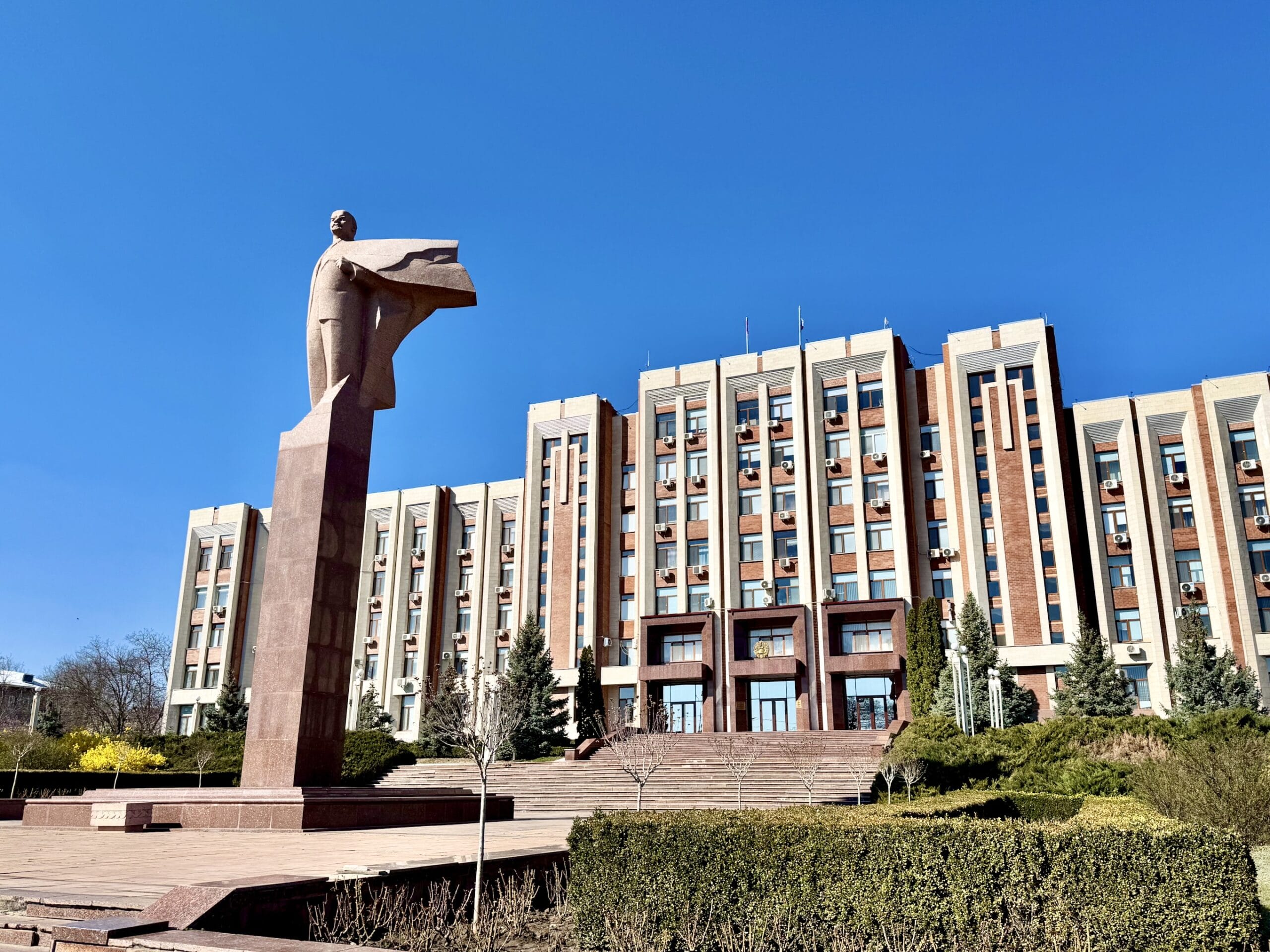Moldova is reportedly Europe’s least visited country, and Chisinau its least visited capital (though during our visit, it wasn’t entirely tourist-free). If that’s true, then what about Transnistria and its capital Tiraspol, which most people have likely never heard of? (I should mention that both destinations have recently gained popularity among travel YouTubers, precisely because of their previous obscurity, so millions may now be familiar with them.)
Before diving into how we traveled from Chisinau to Transnistria, what we saw there, and what you should know if you want to venture off the beaten path, it’s worth sharing some background about the region. Transnistria, officially known as the Pridnestrovian Moldavian Republic, is a breakaway territory that separated in 1992 – following a civil war fought with direct Russian military assistance – from Moldova, which then had recently gained independence from the Soviet Union. Outside of Russia and a few territories with similar status, no other nations recognize it as a country. So while this 4,200 square kilometer (1,622 sq mi) area wedged between Ukraine and Moldova is de jure not a country, visiting quickly reveals that it is de facto one: they have their own currency (Transnistrian ruble), government structure, institutions, passports, license plates, and everything else that constitutes a country.
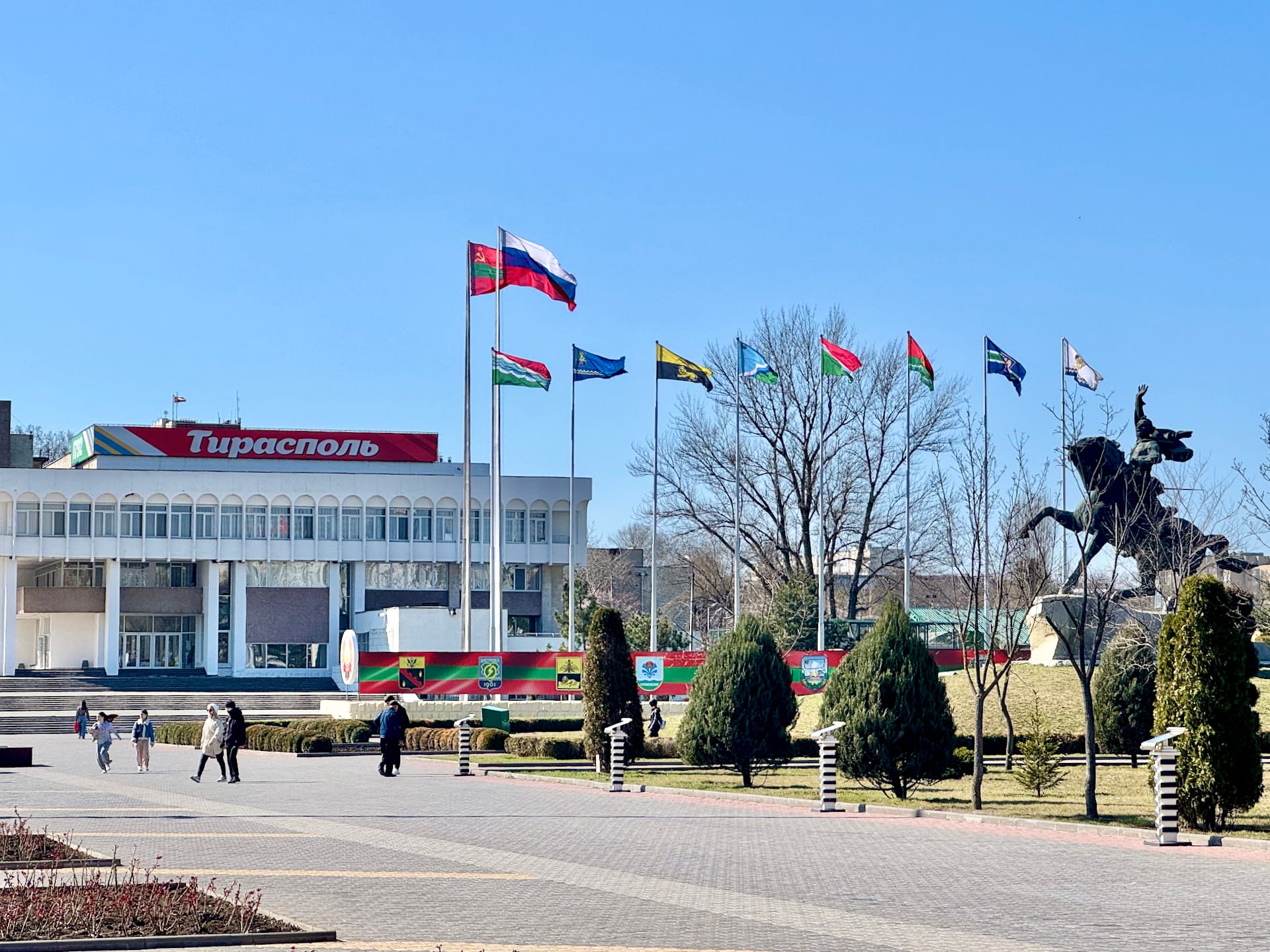
The Council of Europe adopted a resolution in 2022 stating that the territory is under Russian military occupation, which aligns with Moldova’s official position. I don’t intend to politicize this article, but I should mention that this is neither a democratic place nor Europe’s wealthiest region (according to 2021 data, the nominal GDP per capita is approximately 2,600 USD). Its population hovers around 400,000-500,000, and the official languages are Russian, Moldovan (Romanian), and Ukrainian.
Sergey Stepanov, known from Eurovision as “Epic Sax Guy” who became an internet sensation, was born in Tiraspol.
So why has Pridnestrovie become popular among YouTubers and adventure travelers? For two main reasons: first, there’s something thrilling about visiting an officially non-existent country, and Transnistria remains the easiest and safest such territory to visit. Second, this might be the last place on Earth where time genuinely seems frozen in the Soviet Union’s “golden era.” You’ll likely find more Lenin statues per capita here than anywhere else, the architecture is quintessentially Soviet, and hammer-and-sickle symbols and red stars adorn buildings everywhere. For those who, unlike us, didn’t grow up in a socialist country, this offers a genuine glimpse into another world. For Andrea and me, it felt more nostalgic than exotic.
Essential Travel Tips for Visiting Transnistria in 2025
Let’s look at some practical information you should know before departing!
How to Travel from Chisinau to Tiraspol: Transportation Guide
The easiest way to visit Transnistria is to take a half-day trip from Moldova’s capital, Chisinau. If you prefer an organized tour, you can find surprisingly many options online, though their prices seemed excessive (more than 100 USD per person?!) considering the local costs.
While most tours include both the capital Tiraspol and nearby Bender with its fortress, you can arrange a day trip much more economically on your own (round-trip transportation costs approximately $8 USD).
The country’s official local name is Pridnestrovie. The name “Transnistria” is banned within the country and is considered “fascist” and “Nazi” terminology, with usage potentially resulting in a 360 ruble fine or 15 days in prison.
At first, the situation might seem a bit intimidating, and traveling there doesn’t seem straightforward, but it’s actually not complicated at all. It’s best to start in the morning from the Chisinau bus station located next to the market. The marshrutkas (minibuses) to Transnistria depart from the side opposite to the market, and that’s also where you’ll find the ticket office. You can pay by card and a one-way ticket costs around 60 MDL (~$3.5). (You’ll need to buy your return ticket in Tiraspol.)
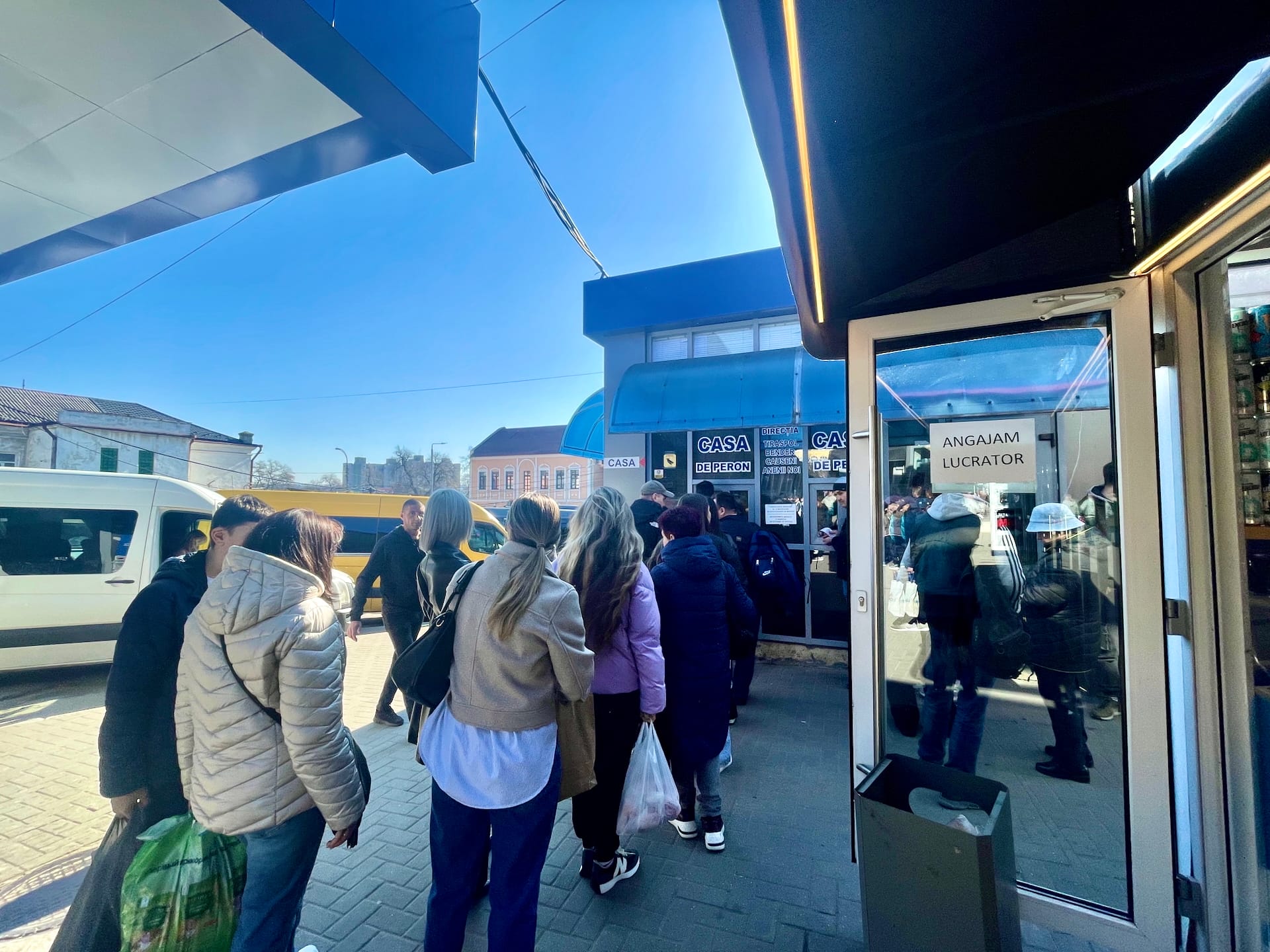
Once you have your ticket, look for marshrutkas with “Tiraspol” or “Тирасполь” signs in the windows (they’ll be right next to the ticket office), or show your ticket to the typical Soviet-looking bus drivers who will direct you to the next departing bus. The buses leave when they’re full. Nobody will really speak English, but this wasn’t a problem for us: within about 2 minutes of purchasing our ticket, we were already seated on the bus. The driver smoked 2-3 cigarettes while waiting for the bus to fill up, and then we were on our way to Tiraspol.
“On our way” might be a bit of an exaggeration. Those who have traveled by marshrutka before won’t be surprised by the experience, but for others, here’s a brief summary. These shared taxis were characteristic public transportation vehicles in the Eastern Bloc (and in some places, they still are). Although they travel from one specific point to another, they can be flagged down anywhere along the route, so they stop relatively frequently. During these stops, passengers get on and off, or people hand packages to the driver who delivers them to an agreed point where someone picks them up. So they function not only as transportation but also as courier and logistics services. (To this day, we still don’t know what was in the red-cross-marked cooler that was handed over at one of the ambulance stations when Peter and I were traveling by marshrutka in Georgia: blood? Covid test samples? Organs?) The journey with these stops takes about two hours to reach the Tiraspol train station.
Border Crossing and Visa Requirements for Transnistria
After approximately an hour of bus travel, you’ll reach the border. On the Moldovan side, there’s no checkpoint (understandably, since they don’t recognize Transnistria as separate territory), perhaps just a police car parked roadside. Shortly after, you’ll arrive at the Pridnestrovian border crossing, which resembles a standard border checkpoint (except for the red star and hammer-and-sickle emblem). Here, we encountered heavily armed masked Russian soldiers (they make no secret of their identity, wearing Russian flag patches). If that wasn’t intimidating enough, the bus driver loudly warned “photo: problem” – indicating it’s inadvisable to take pictures at the border crossing. The visa issuance occurs in a small building, much like anywhere else: you surrender your passport, they examine it, and instead of stamping it (which would invalidate it), they provide a small document called a “Migration Card” valid for 12 hours.
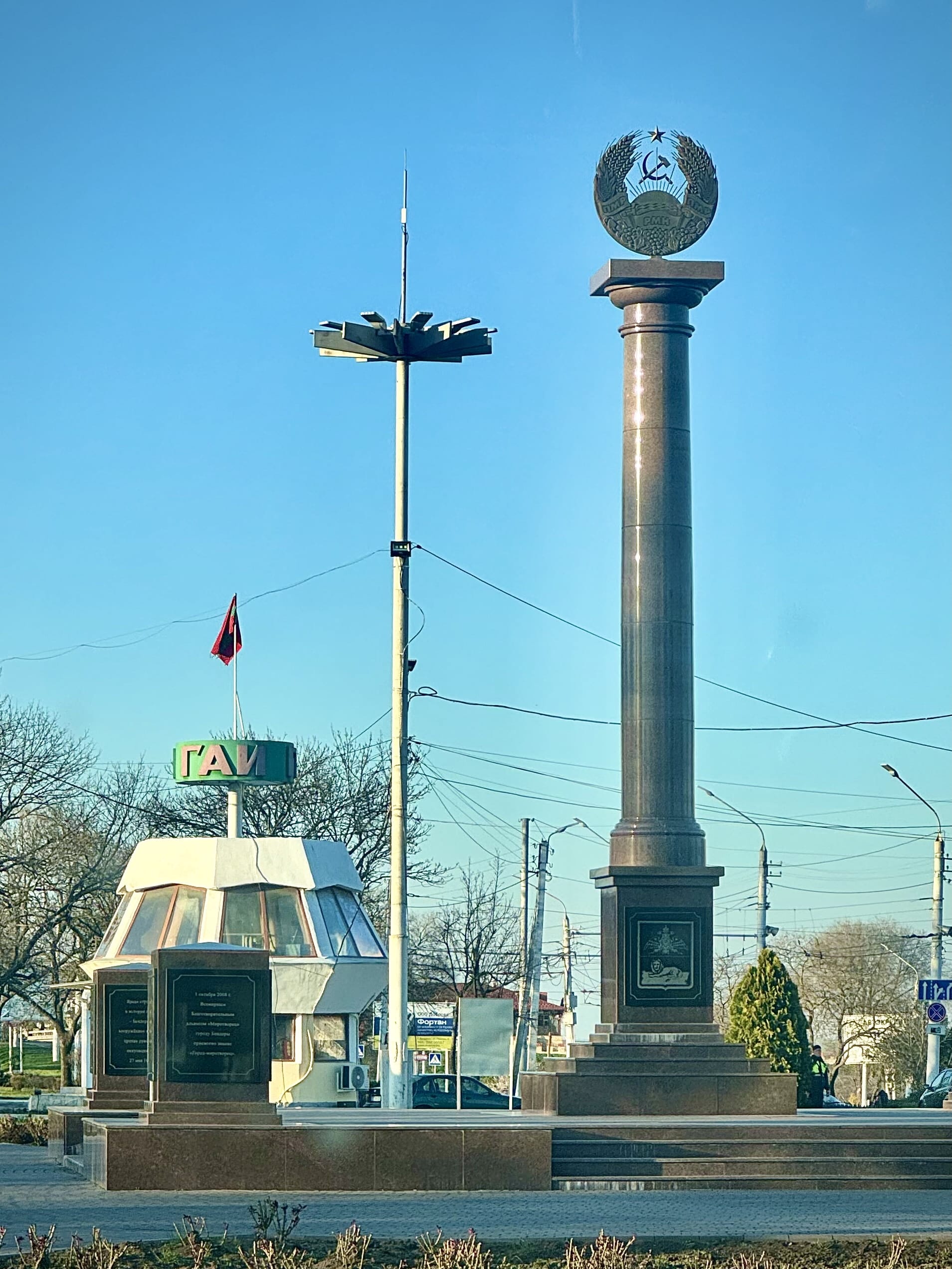

The situation was a bit more intense on the way back, as a soldier boarded the bus at the border crossing and collected everyone’s passports. If there’s anything that makes a traveler nervous, it’s having their passport out of sight, especially in a Russian-occupied territory during the Russian-Ukrainian war, right next to Ukraine. Thankfully, our documents returned without issue minutes later, and our thoughtful driver even stopped briefly after the checkpoint to let everyone confirm they had their passports back.
Arrival
After crossing the border, you’ll first pass through Bender (where many passengers disembarked from our bus) before reaching Tiraspol. The bus travels along Strada Karl Liebknecht toward the train station. Our driver stopped at Lenin Street corner and mentioned (in Russian) this was the ideal spot to disembark for the center. He was right – we only continued to locate the train station for our eventual departure.
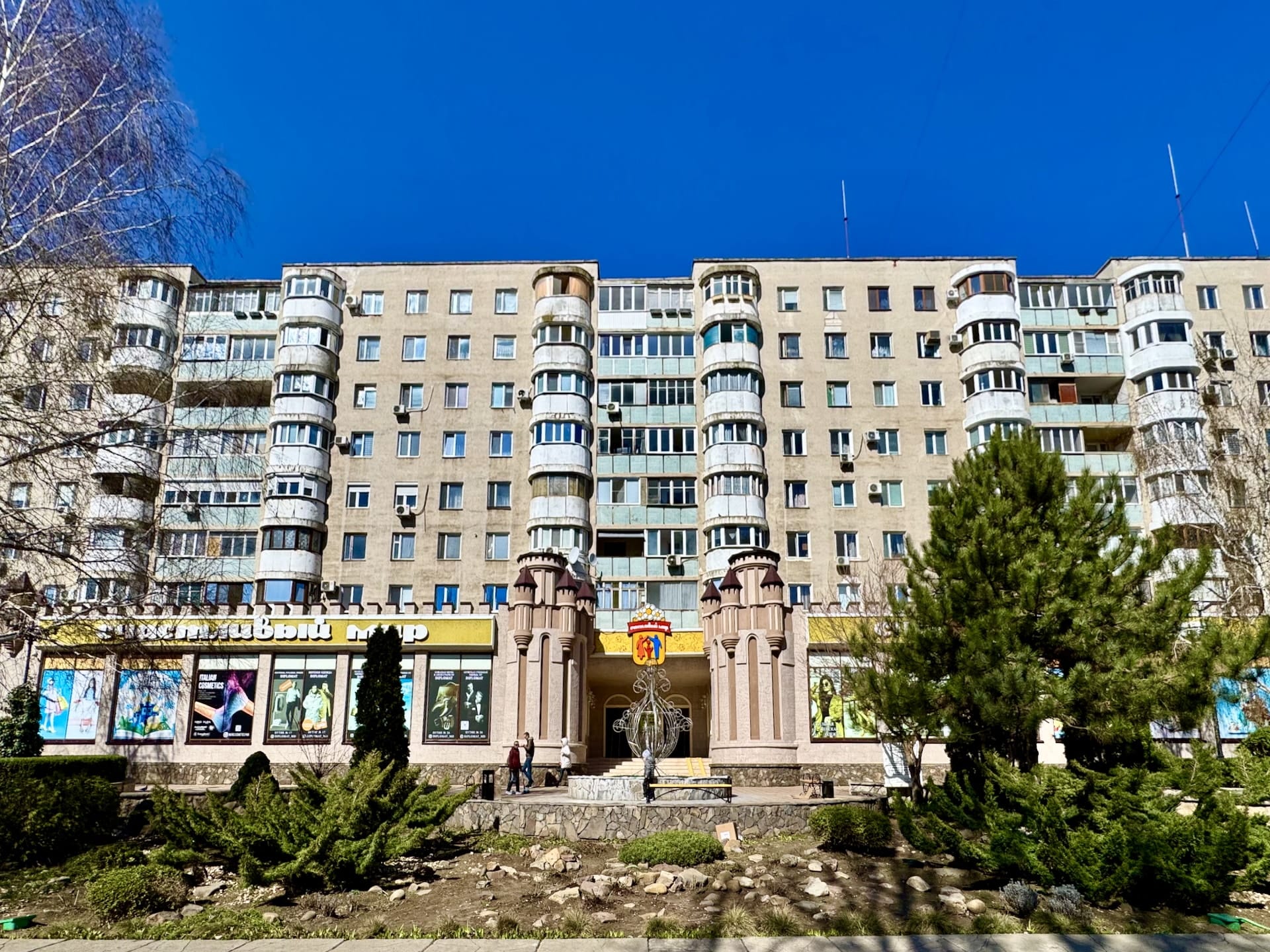
We witnessed a nerve-wracking incident here. A Czech couple got off at the corner, but the man left his passport on the bus. Imagine what might have happened if the last local passenger hadn’t alertly notified our driver, who quickly made a U-turn, sped back, found the tourists, and returned the forgotten passport.
Transnistrian Ruble: Currency Exchange and Payment Options
As mentioned, Pridnestrovie uses its own currency, unavailable outside its borders. Within the country, the Transnistrian ruble is your main payment method. Some places might accept Moldovan lei (MDL), but Western bank cards won’t work for payments or ATM withdrawals – they operate their own payment system, cut off from international networks.
Despite visiting on a weekend, we found an open bank on the main street (25th October/Pokrovskaya Street) to exchange Moldovan lei for local rubles. While most banks were closed, “Эксимбанк” (marked by a yellow sign) at Manoilov Street corner was open. During our early 2025 visit, they gave 0.89 rubles per leu. We exchanged 500 MDL, which proved insufficient, so we later exchanged 20 euros at a Sheriff store (more on Sheriff later).
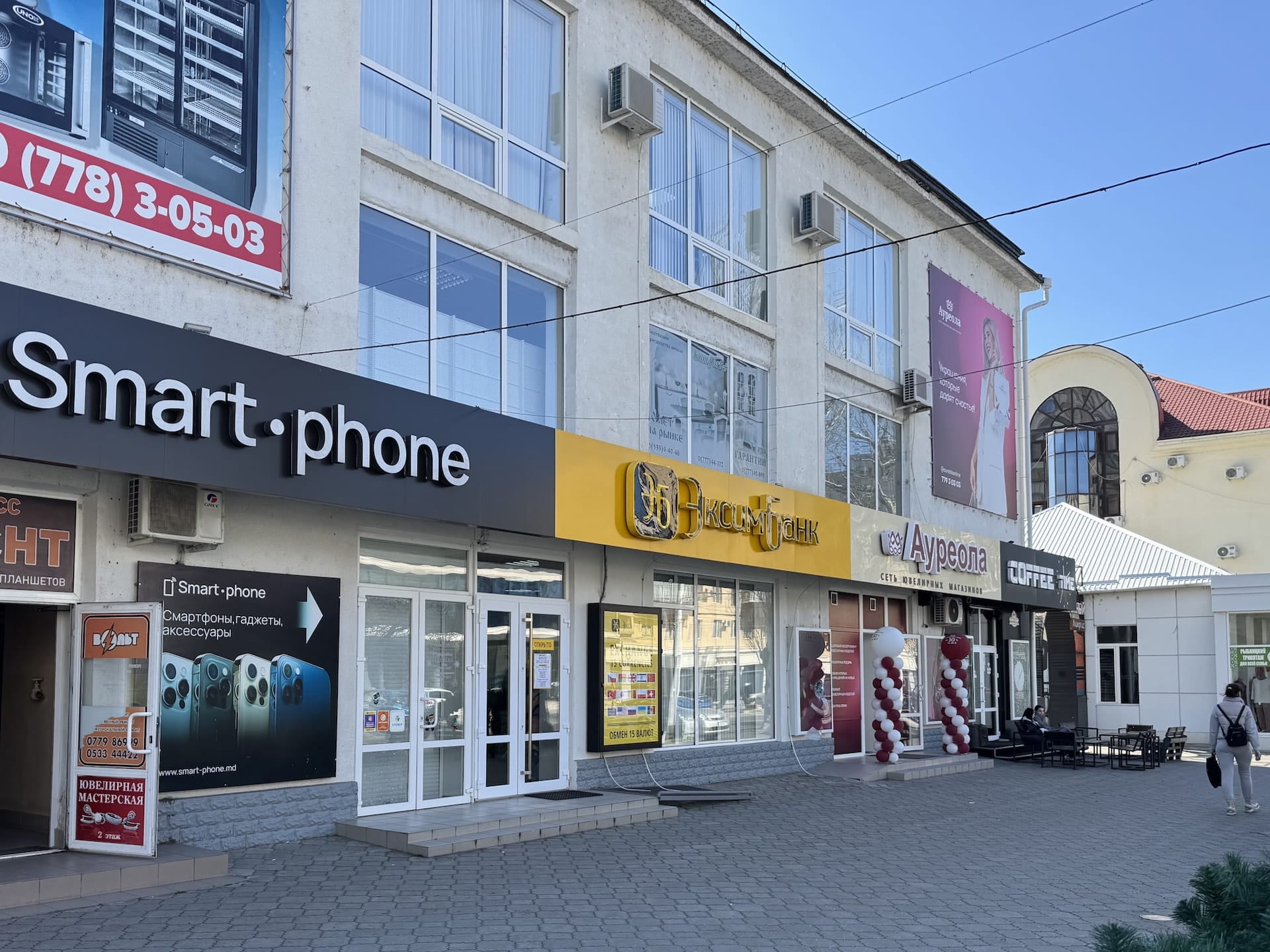
We were intrigued by the famous plastic coins reportedly unique to Transnistria. Despite seeing advertisements for them and actively seeking them as change, we never received any. Perhaps they’ve been withdrawn or are kept from tourists to not serve as souvenirs, but I couldn’t spot any even when peeking into cash registers.
Internet Access and Mobile Connectivity in Transnistria
Transnistria maintains its own mobile communications network. Consequently, foreign SIM or eSIM cards in your devices won’t connect to their network. We arrived with Moldovan eSIMs by Manet, which briefly detected a network after crossing the border but completely lost signal in Tiraspol. While I’m unsure about the local SIM situation, I suspect it’s challenging for foreigners to acquire one, though for a brief visit of a few hours, you won’t necessarily need connectivity. Definitely download offline maps to your device to navigate without getting lost. (However, as you’ll discover, Tiraspol isn’t particularly large or difficult to navigate.)
Return Journey
The return journey is by marshrutka, just like the outbound trip. The buses depart from the train station at the end of Lenin Street (where you arrived if you stayed on the bus the whole way), and now you’ll need to look for the “Chisinau” or “Кишинёв” sign on the buses. You can buy tickets inside the station building; in our case, it cost around 65 rubles, so it was more expensive than the outbound journey. It’s important to have enough cash left for the bus. It’s good to prepare with a bit more in case ticket prices change (or you can ask about the price when you arrive). You technically can’t take the remaining money out of the country (of course, we brought some as souvenirs, but shh!), but there are small cafés and shops around the station where you can spend your change.
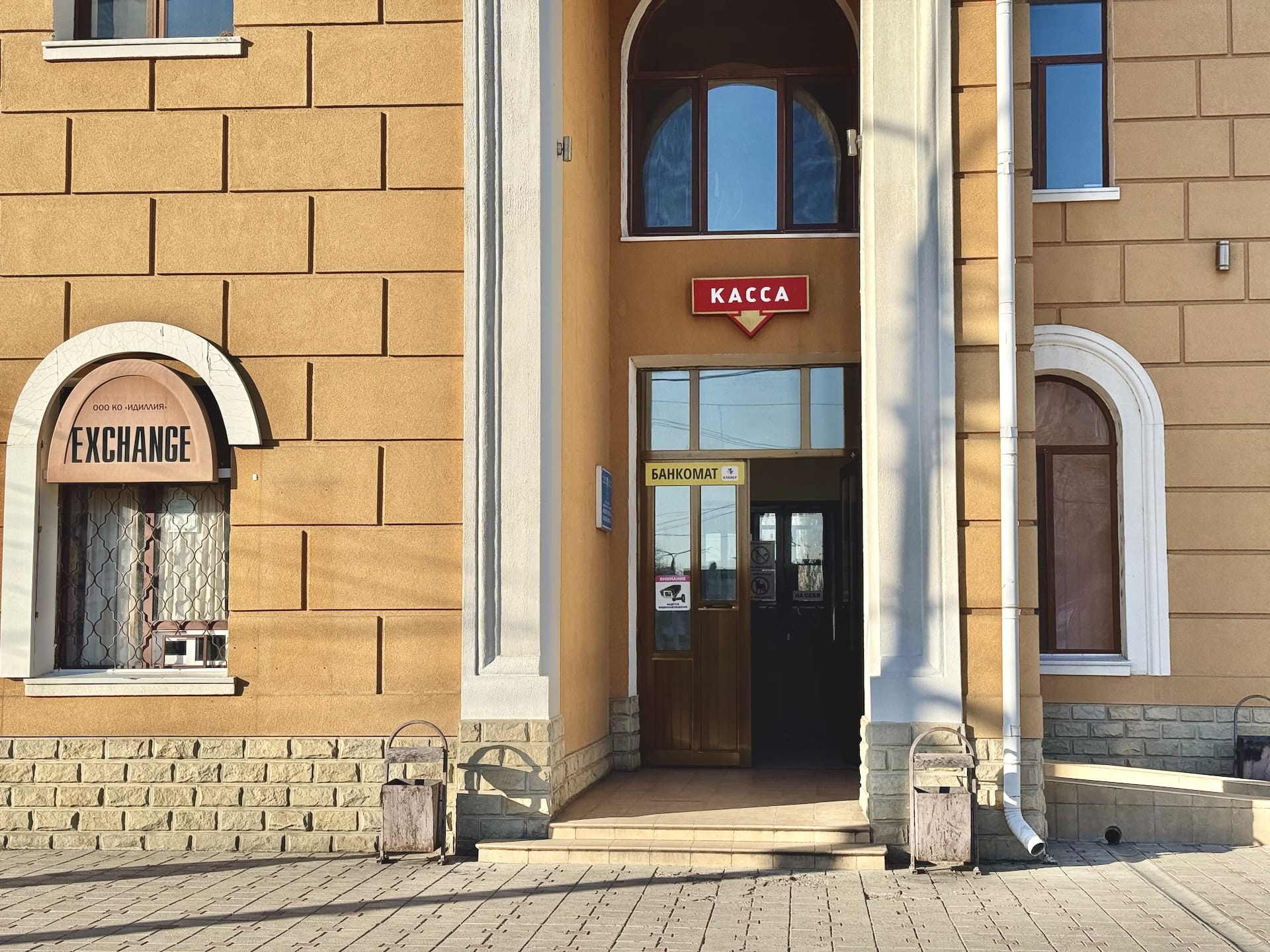
Previously, trains ran from the train station only toward Ukraine, but after the Russian invasion, Ukraine closed its border with Transnistria, so currently only marshrutkas depart from here.
You can also flag down the bus on January 9 Street just as you can get off on the way there, but I wouldn’t necessarily recommend this. When we were returning in the afternoon, there were barely 1-2 free seats on the bus at departure, which were quickly filled at the first flag-down, so quite a few people had to stand for almost the entire journey (I don’t know how legal this is…).
Top Attractions in Tiraspol: Soviet-Era Sightseeing Guide
Obviously, you can’t explore an entire city in just a few hours, but Tiraspol’s key attractions fit comfortably into a brief excursion. Here’s our itinerary! We walked everywhere, without using taxis and trolleybuses – based on our Chisinau experience, these likely operate by paying the conductor upon boarding.
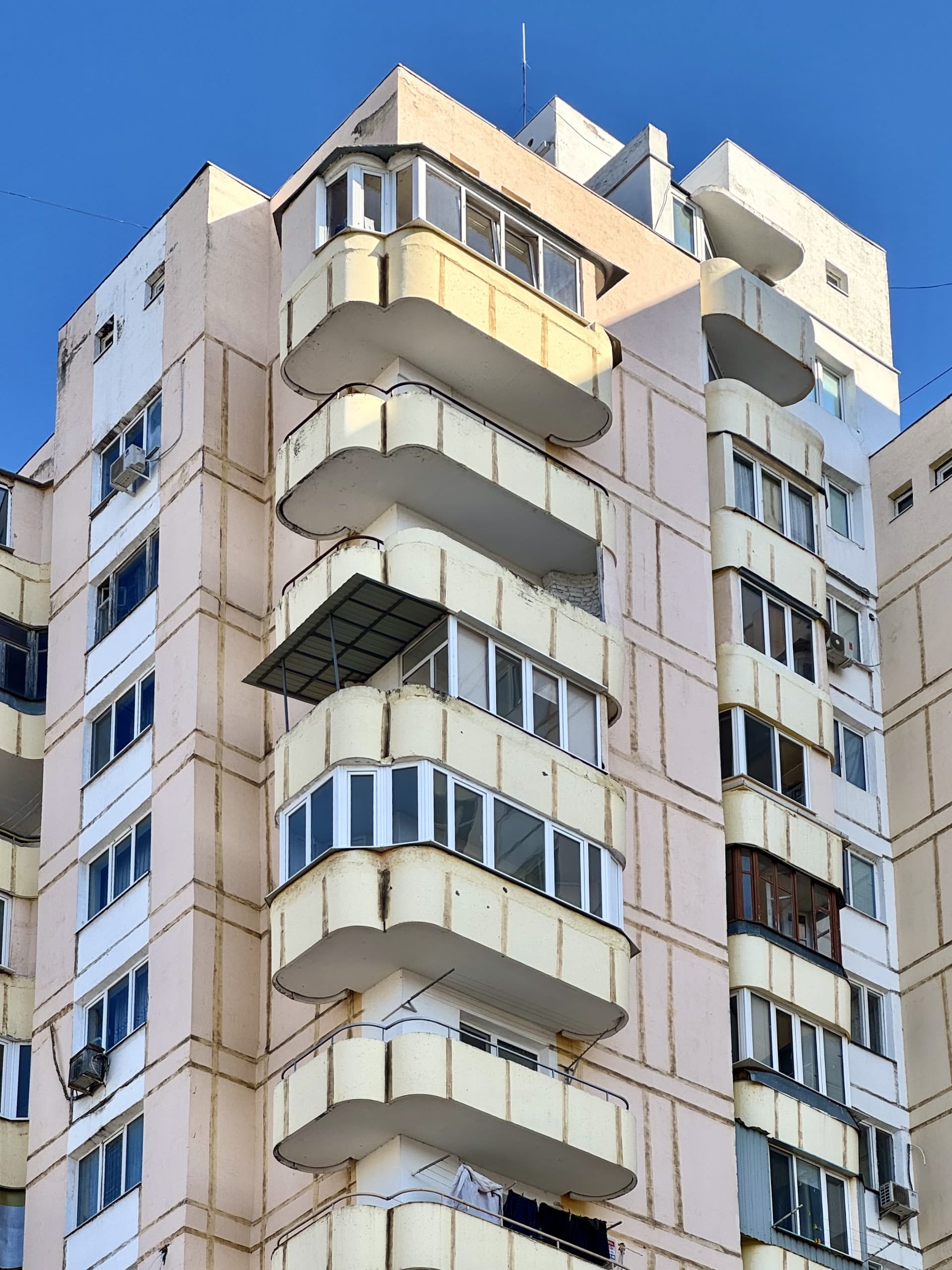
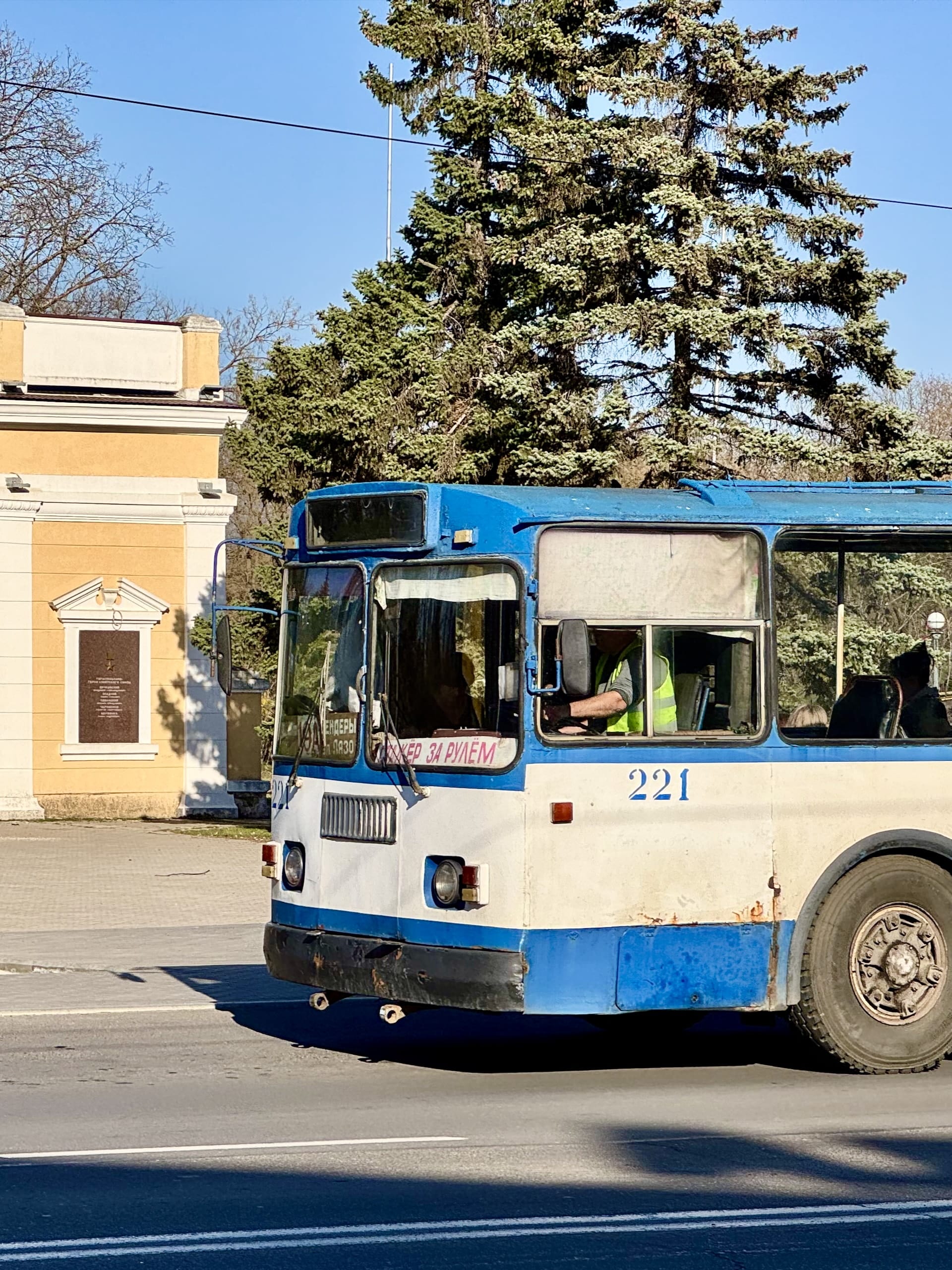
25th October Street: Tiraspol’s Main Avenue
We spent most of our time walking up and down what appears to be the main street, 25th October Street, as most attractions are located around it. From the bus, we walked down Lenin Street, then first turned right (west), walked to the government building, then turned around and headed east to the theater, then to Victory Park, from where we walked back to the train station through some smaller back streets.
Suvorov Square: Soviet Architecture and Military History
About 1 km (~0.6 miles) from the Lenin Street corner stands this impressively vast Soviet square named after a Russian general. Here, you can admire Suvorov’s equestrian statue, several socialist-style buildings (cinema, youth palace), and photograph the Pridnestrovian coat of arms. On the square, alongside the breakaway state’s flag, flies the Russian flag and banners of other territories that have separated under similar circumstances (i.e., Russian military intervention). This location hosts military parades annually on May 9 and September 2.
There’s a public restroom on the square that can be used for 2 rubles (~$0.20 USD).


St. George’s Chapel and Historic T-34 Tank Memorial
Directly opposite the square stands the Memorial of Glory, commemorating victims of various wars and operations (including those who secured Chernobyl after the disaster). You can examine names and inscriptions etched in granite and view the eternal flame, but what typically captivates tourists is the T-34 tank displayed on a stone platform, brought here from Hungary (its crew perished during Budapest’s 1945 siege). The inscription “ЗА РОДИНУ!” on the tank translates to “For the motherland!”
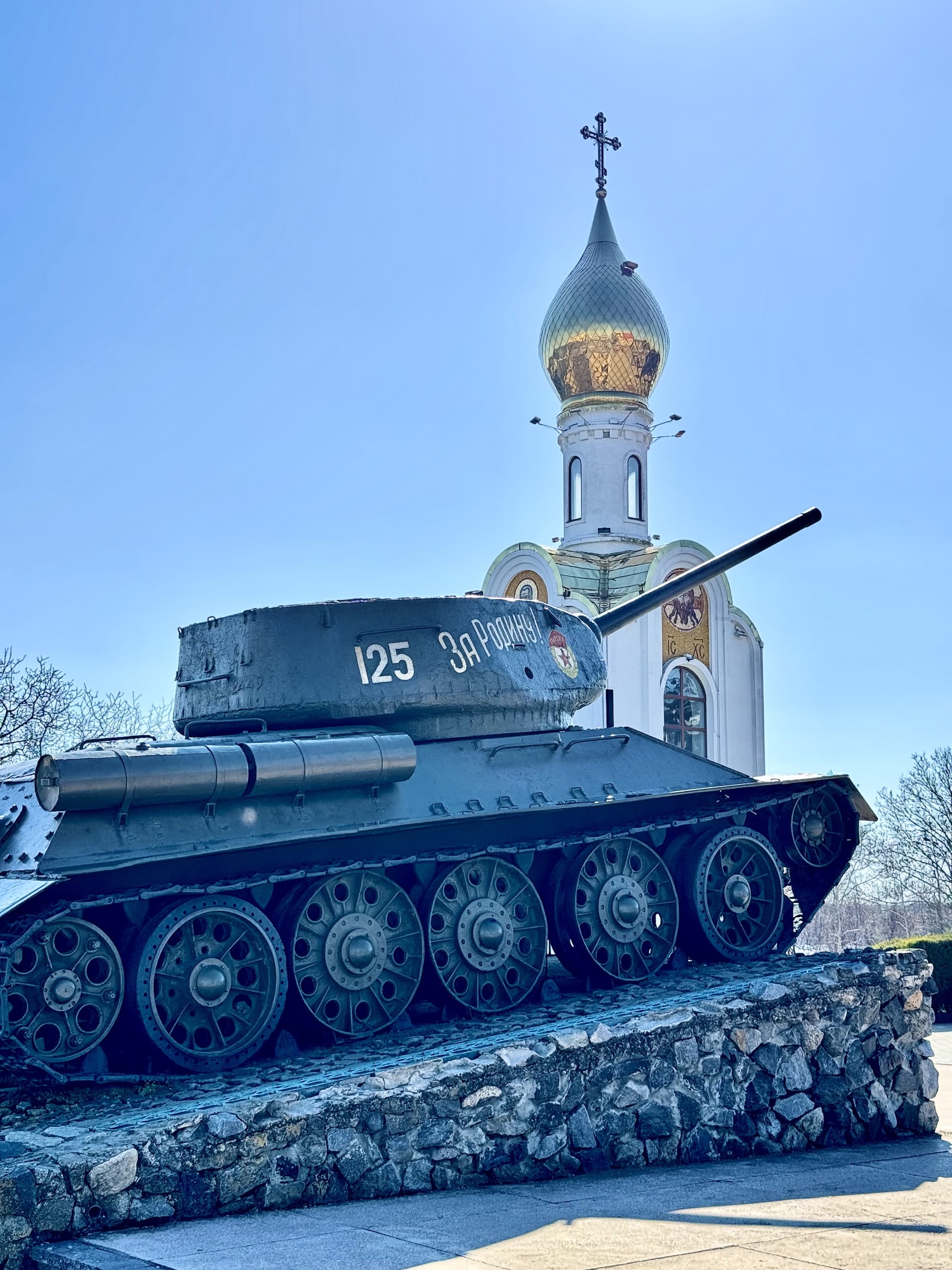
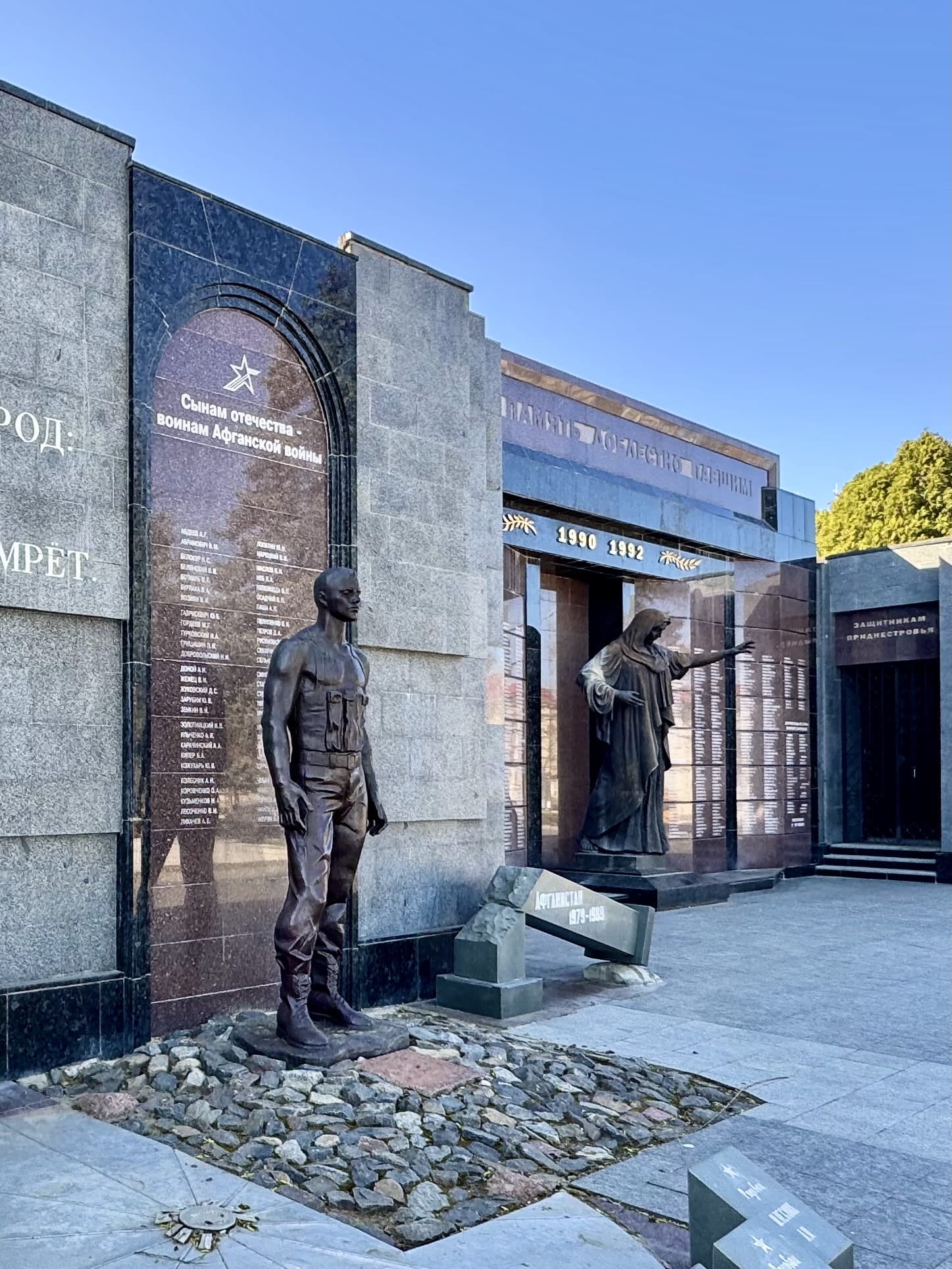
Behind the tank, on the river side, is St. George’s Chapel, a small onion-domed building. Here, you can take that famous photo where both a tank and an Orthodox chapel are visible in the same frame.
Transnistrian Parliament and Lenin Monument
Just steps away stands the Transnistrian “parliament,” officially the Supreme Council building. Before this Soviet-style structure, you can admire an impressive Lenin statue – together, they create an excellent photo opportunity.

Tiraspol City Hall
In the other direction from Lenin Street is the City Hall, a snow-white socialist building that was decorated with large vertical Pridnestrovian flags when we visited (I’m not sure if it’s always like this). If you’re interested in Soviet artifacts, you can appreciate not only the star on its top but also the Lenin bust in front of it. On the eastern side of the building, you can see the heroes’ monument.
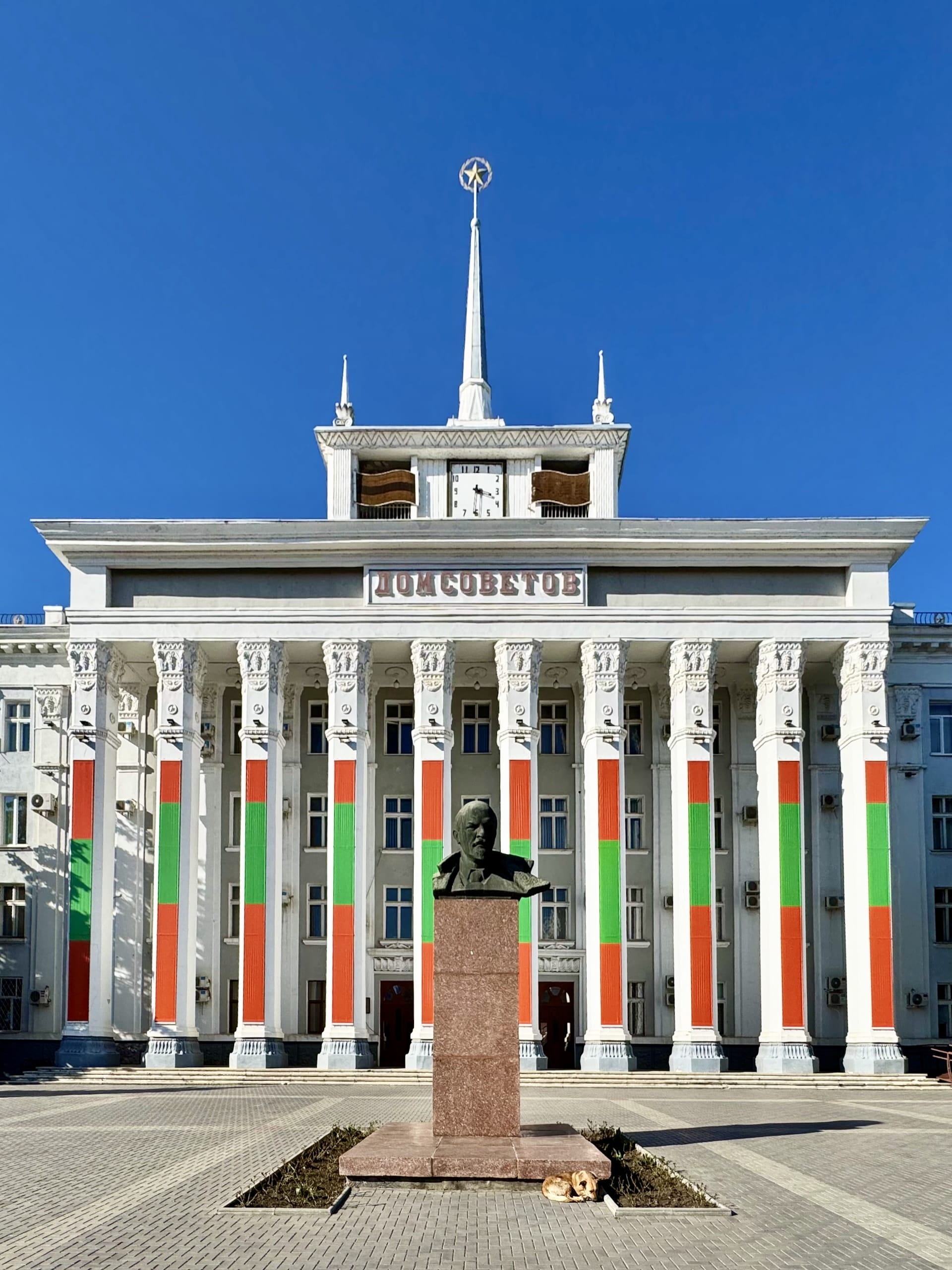
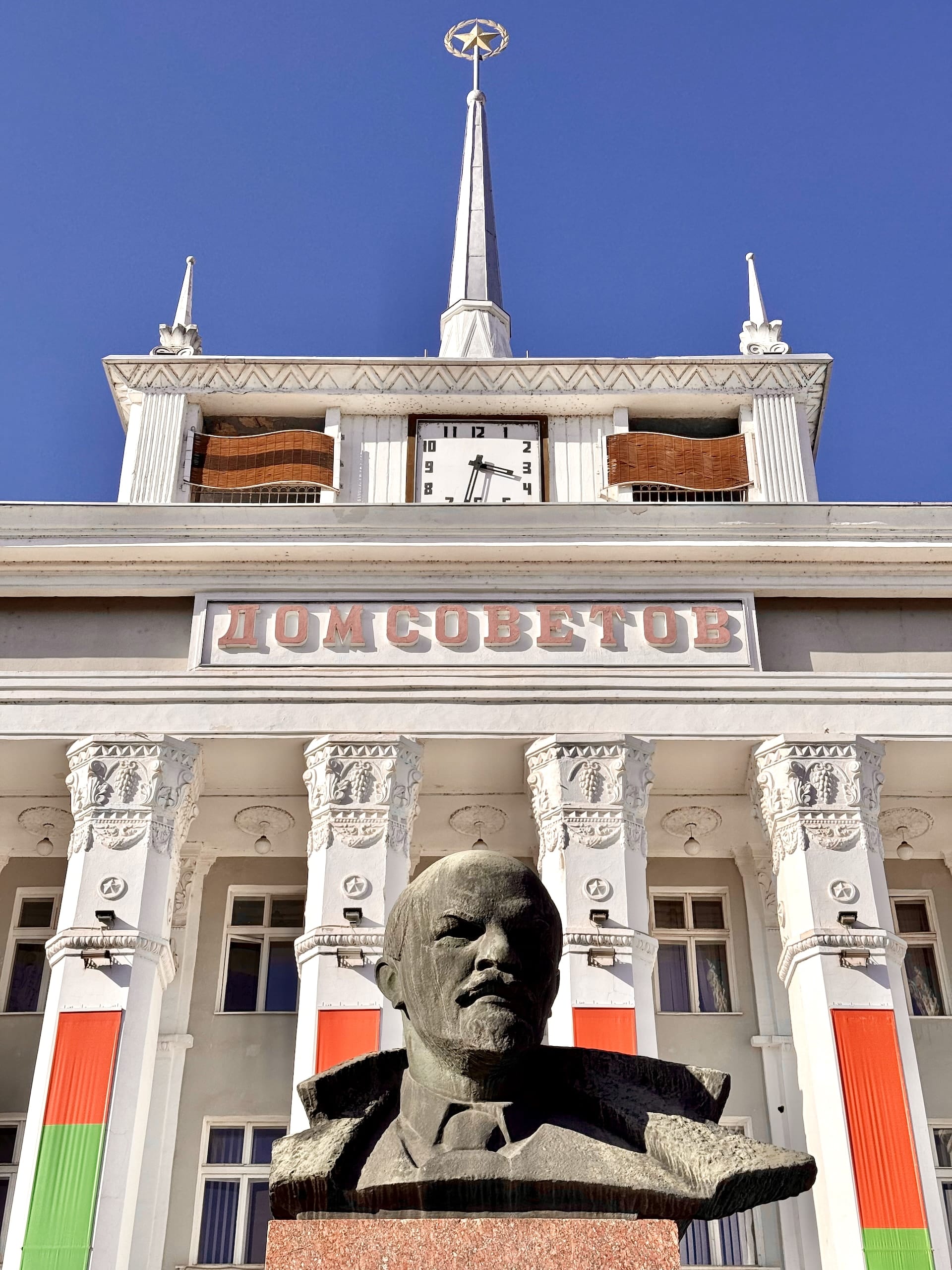
Theater
Near Victory Park, essentially at the end of 25th October Street, is the not-particularly-distinctive socialist realist Drama Theater building.
Victory Park
Walking a bit further past the theater, you reach Victory Park (ПАРК “ПОБЕДА”). Here, besides the actual park, we stumbled upon a small amusement park (or rather, a “fairground” familiar from the Eastern Bloc) that had seen better days (not operating during our visit), with a ferris wheel a bit further away. Apparently, this still operates, although it didn’t look very reassuring from the outside, and there wasn’t anyone there to let us in – even if we had dared to ride it. In the middle of the park, you can see the statue of Grigory Ivanovich Kotovsky, a Soviet military officer.
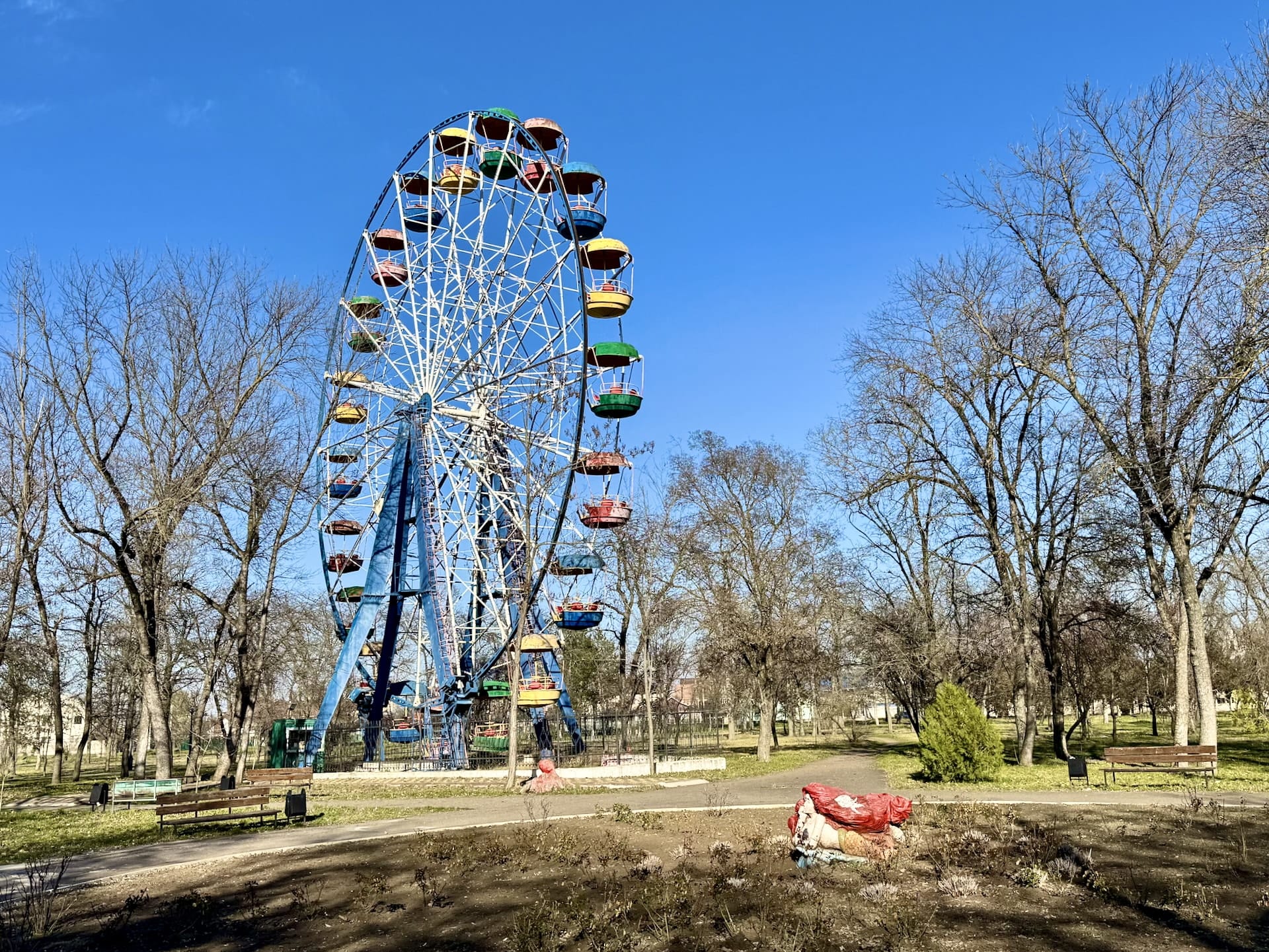
From here, we headed back to the train station through smaller back streets, which passed through a housing project, allowing us to see what the local reality is like when it’s not about the grandiose, well-maintained government buildings.
Where to Shop in Tiraspol: Souvenirs and Local Markets
We purchased minimal items during our brief city visit, but two shopping destinations deserve mention.
House of Books: Soviet Memorabilia and Unique Souvenirs
The first notable mention is the Дом Книги (literally House of Books) bookstore. While they have some very interesting vintage books if you want a relic from the Soviet era, what makes it even more worth visiting is that here you can stock up on genuine Transnistrian souvenirs. They have fridge magnets (including some quite interesting ones), posters (who wouldn’t want Stalin smiling back at them from the wall at home, right?), and other items. You’ll find these in the back of the wonderfully old-book-scented store, near the cash register.
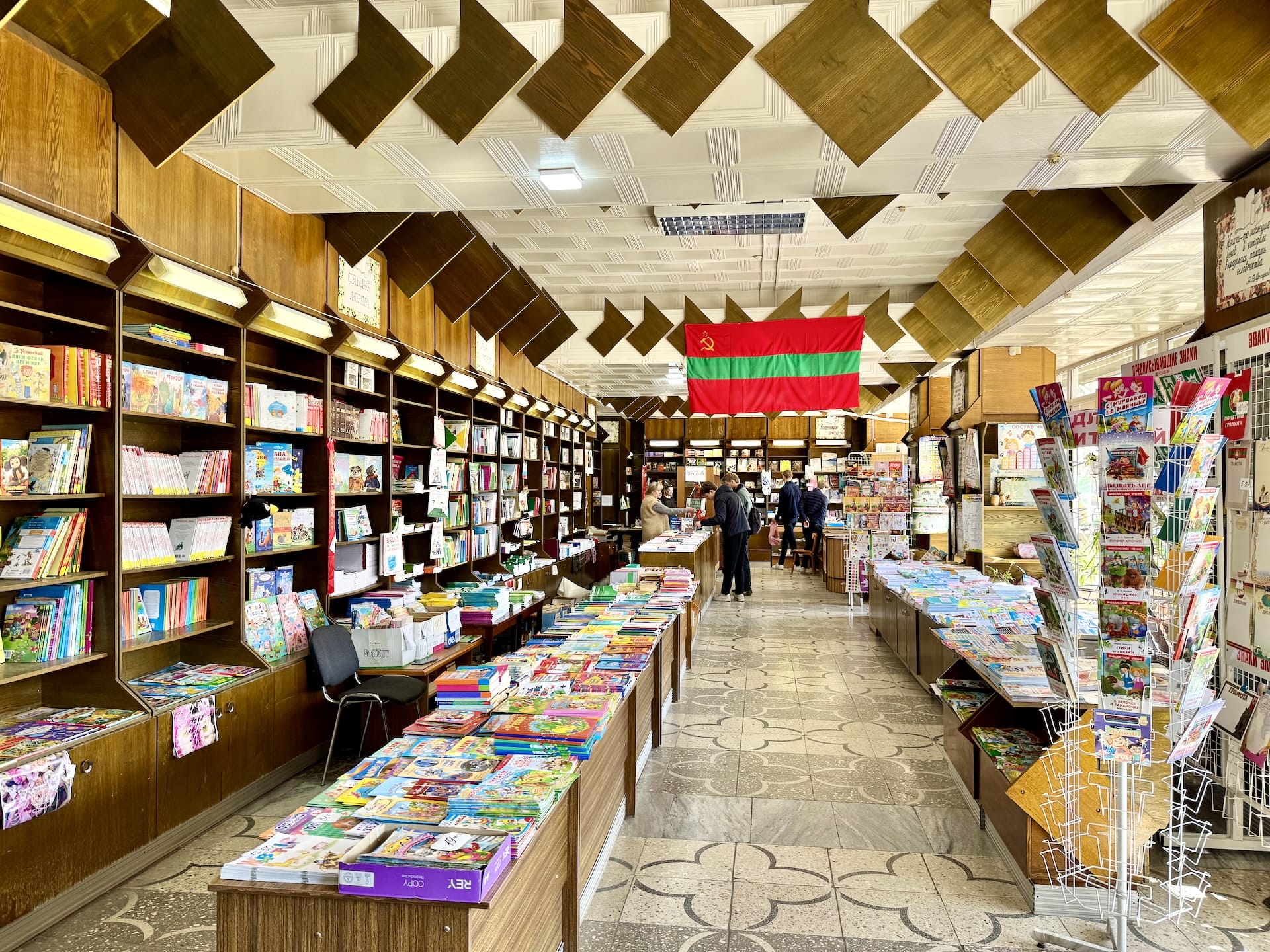
Sheriff Supermarkets: Monopoly and Economic Reality
The Sheriff network (Шериф) is an interesting phenomenon in Transnistria, so we’re dedicating a separate section to it. As soon as you arrive in the city, you might notice that this business empire, founded by two former KGB agents, practically dominates the country. On the way to Tiraspol by marshrutka, you’ll first pass the Sheriff stadium (home field of Sheriff FC), then a Sheriff gas station. There are numerous Sheriff supermarkets in the city, but there’s also a Sheriff TV channel, Sheriff construction company, Sheriff Mercedes dealership, and even the mobile service provider is Sheriff. State-supported oligarchy at its maximum.
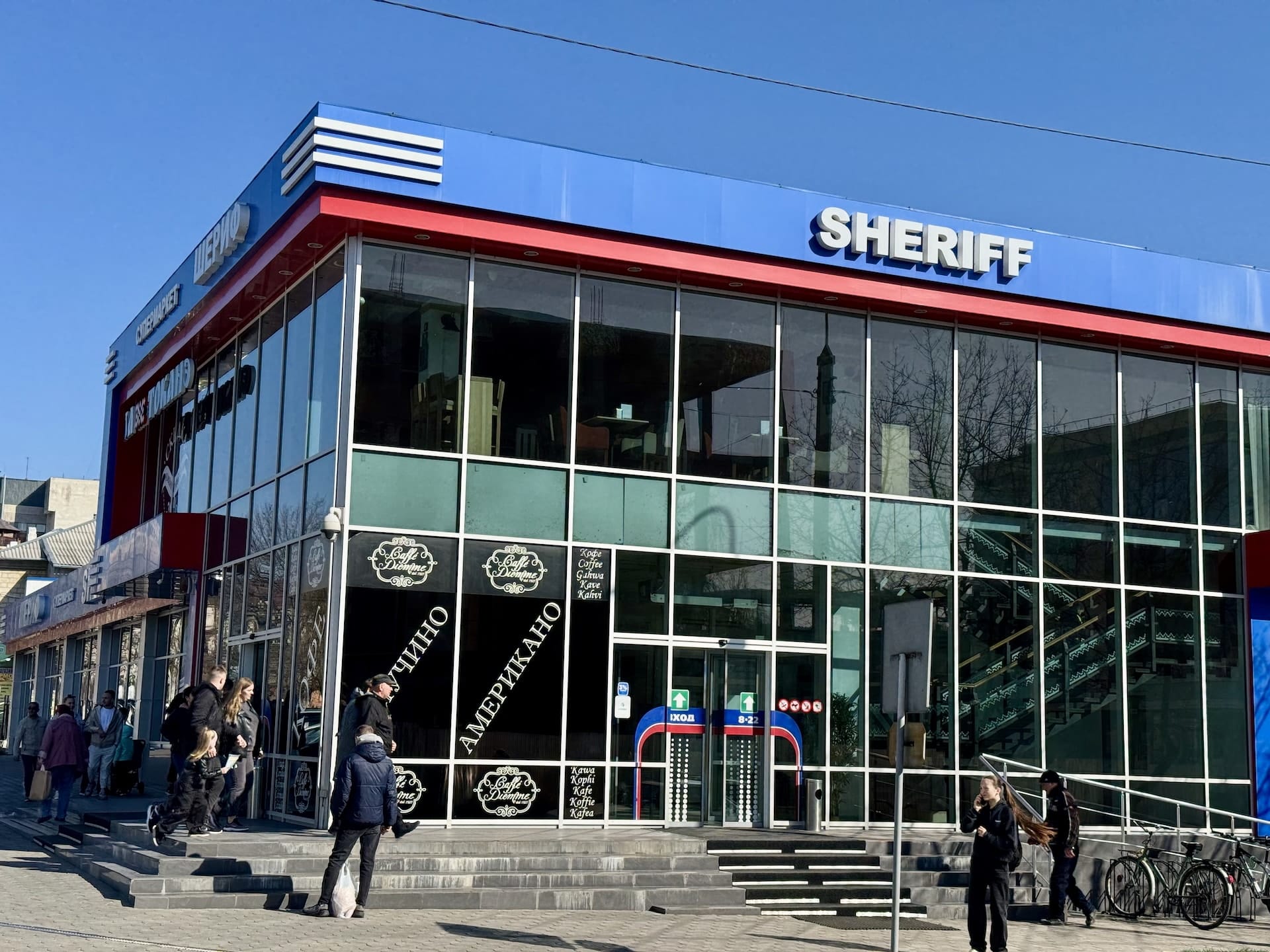
We visited Sheriff supermarket #20 hoping to bring home authentic Transnistrian products but left disappointed. Most shelf items were Ukrainian, with some Moldovan and Russian goods mixed in. The irony is striking – this fiercely pro-Russian territory (where Russian and Pridnestrovian flags fly together everywhere, and leaders have expressed desire to join Russia) relies heavily on Ukraine for everyday consumer goods.
Inside the entrance area sits an Agroprombank (АГРОПРОМБАНК) branch, open even during our Saturday visit – another currency exchange option.
Transnistrian Cuisine: Where to Eat in Tiraspol
Since you’ll realistically spend only a few hours in the country, your dining options will be limited. We primarily visited establishments clearly designed for tourists – though curiously, locals frequented them too.
Cantina URSS: Authentic Soviet Cafeteria Experience
As you come into the center on Lenin Street, immediately after the corner before 25th October Street, in a basement, you’ll find this genuinely Soviet restaurant. Going down the stairs, you enter a long, dimly lit corridor decorated with Soviet relics, at the end of which is the counter with the food.
It’s a classic cafeteria-style place, meaning you take a tray and cutlery (optionally bread), tell them (or rather indicate, since the staff doesn’t speak English) what you want, they put the food on a plate, put it in the microwave for two seconds which naturally leaves it ice cold, and after paying, you walk over to a dining room where you can eat. We were greeted with a classic socialist menu featuring dishes familiar to us but probably without English names (e.g., “beef roulade”), as well as famous Slavic soups (borscht, solyanka).

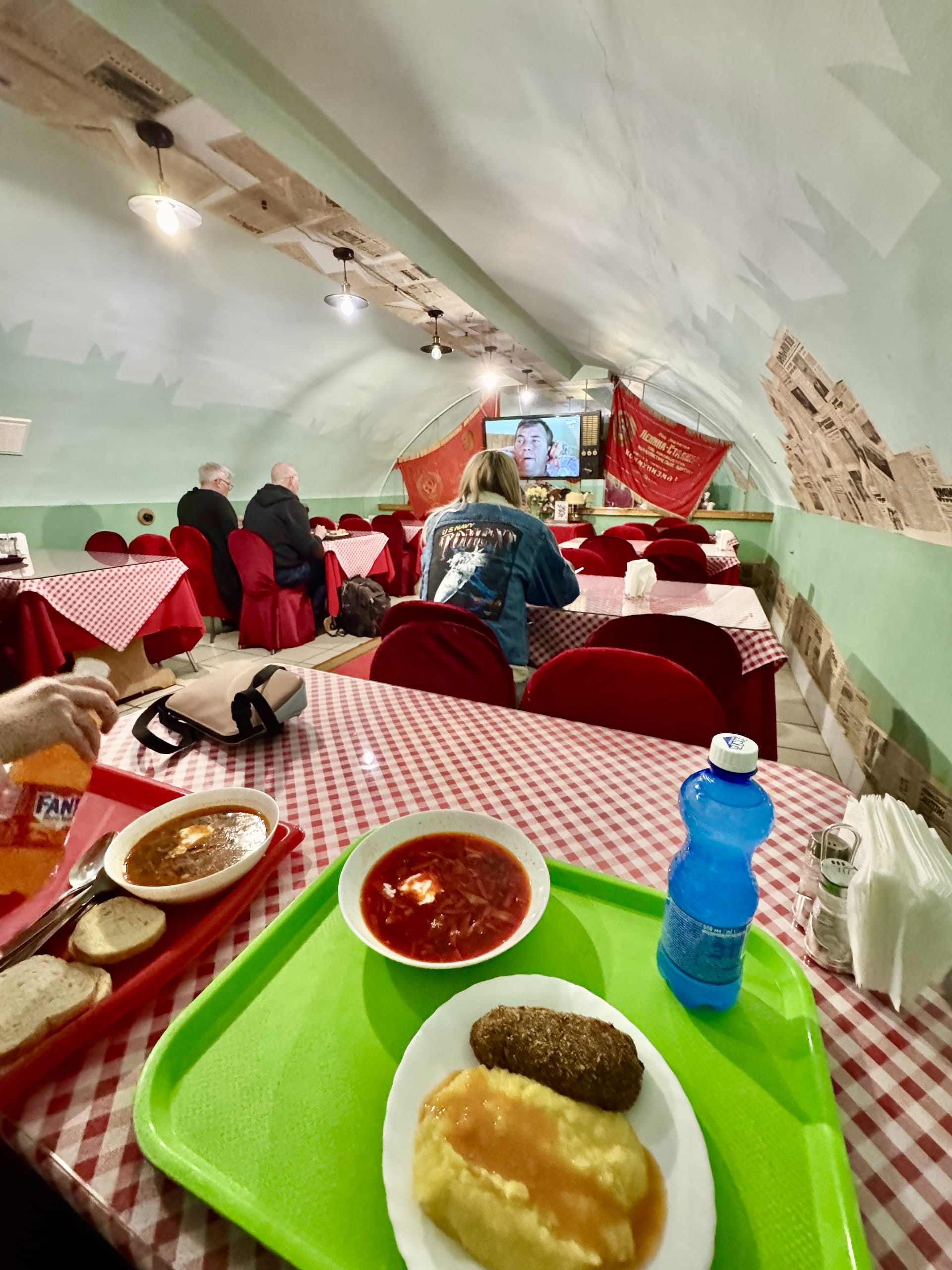
There are two larger dining rooms, both decorated with Soviet decor, and both had some Russian program playing on TV – a comedy in one, and a musical show in the other. The food absolutely evoked nostalgia for our childhood, though not necessarily in a good way. They weren’t actually bad, but they could have used a bit more microwaving. I don’t remember the prices exactly, but they were surprisingly high given the quality and portions; we paid around $8 USD per person including some imperialist Coca-Cola products (perhaps the latter were expensive).
Back in the USSR Restaurant: Soviet-Themed Dining
A very similar restaurant to the previous one (though not in a basement, and with an outdoor seating area). We originally planned to stop here for an early dinner before heading home, but we weren’t hungry at all in the end, so we skipped it. Based on the pictures on Google Maps, the selection seems larger here, and the food appears to be of better quality, but interestingly, the average rating is the same as the other restaurant.
House of Bakery: Modern Café for Coffee and Pastries
We thought we’d check out a place where everyday local people apparently go and that isn’t built around the Soviet past. We chose the elegant-looking House of Bakery café (it has an English name, bah!) on 25th October Street. Here, besides coffees and pastries, you can also have simpler lunches, so if you’re not attracted to socialist gastronomy (though if you’re already here, why would you miss it?), you can have lunch here too.
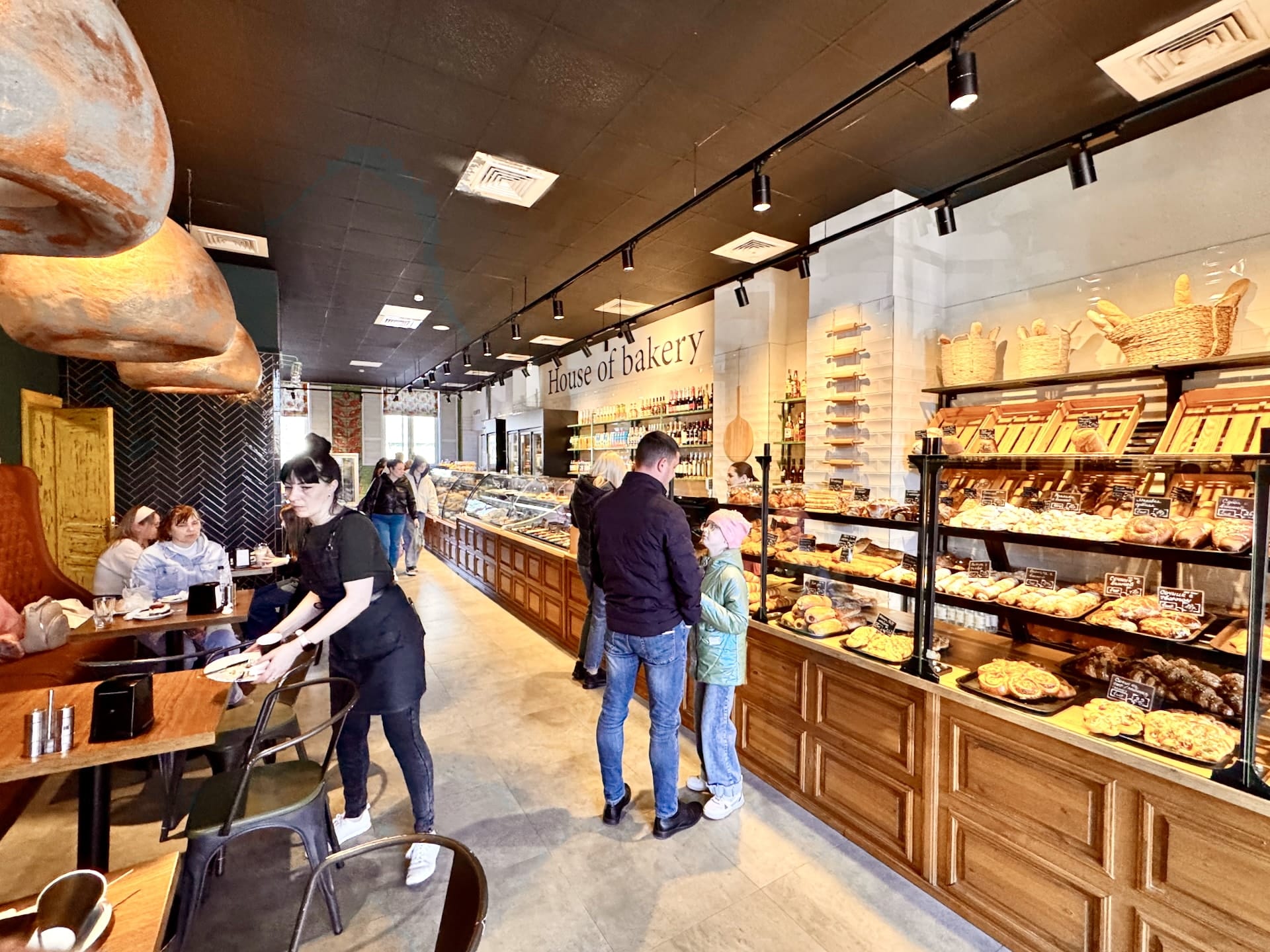
We had coffees (which were quite good) and a slice of incredibly sweet coconut roll cake as thick as an arm (and took the rest with us to eat the next day), which was obviously such a large portion due to the language gap.
This is also where we first tried to see if normal bank cards really don’t work in the country, and I can confirm that none of the three cards we tried worked.
Is Transnistria Worth Visiting? Final Thoughts
So, this is what we saw during our few-hour excursion to Transnistria, the country that officially doesn’t exist, and whose unofficial existence not many people know about. I’d categorize it as an “extreme” tourist destination, fortunately not because there would be any problems with public safety or similar issues, but because it might be exciting for people with special interests.
I completely understand that for someone who grew up outside the Soviet sphere of influence, this world where time seems to have stopped at least 30 years ago is very exciting. You can see many socialist-style buildings, and the various statues, posters, and monuments truly evoke the Soviet Union’s heyday.
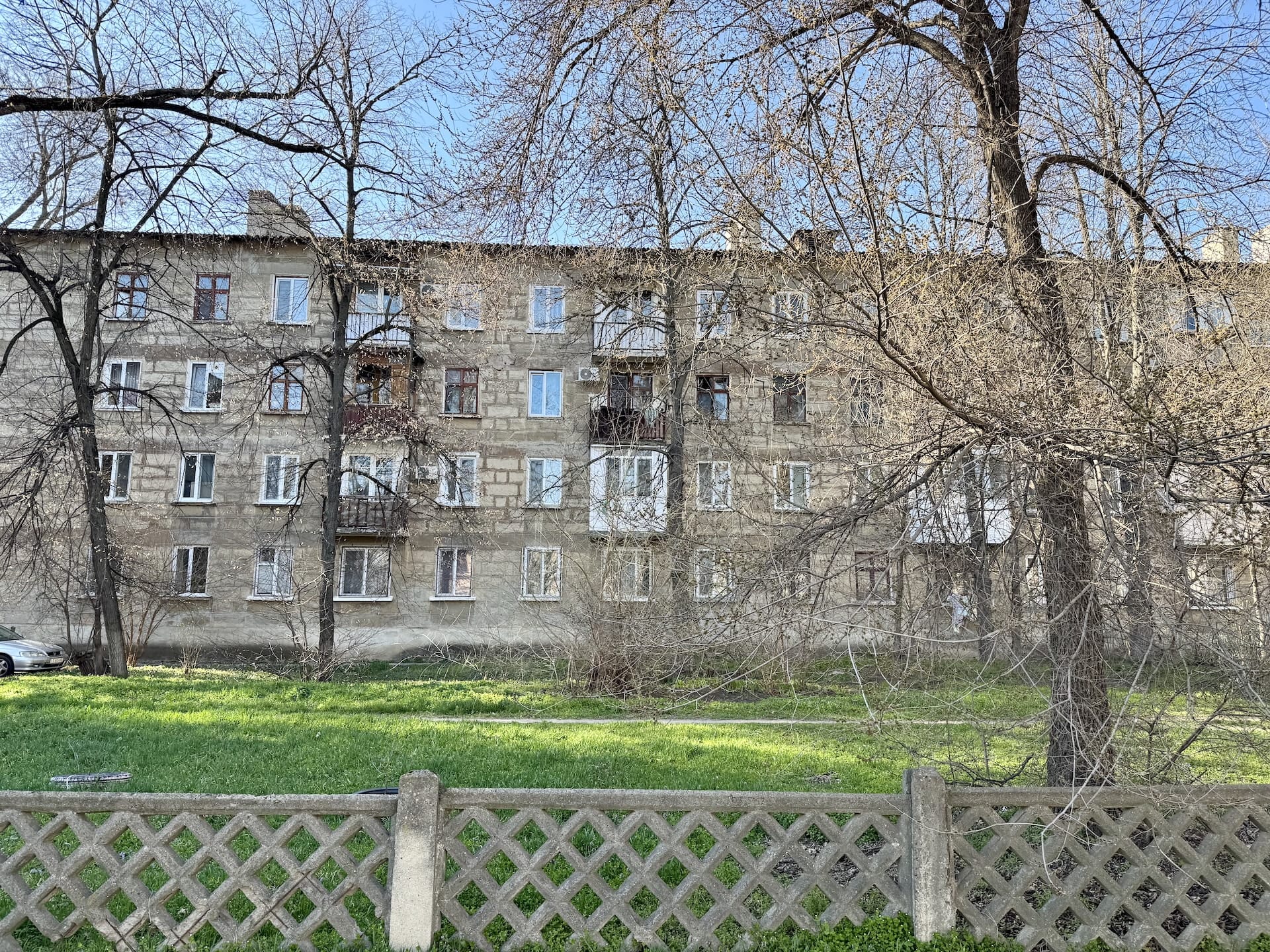
For us, who spent at least some time as children in socialism (although never in the Soviet Union), Transnistria wasn’t so surprising. Similar buildings existed (and still exist) in our country, we ate the same food in kindergarten/school, and the whole aesthetic and atmosphere was familiar to us. But for those who (fortunately) didn’t experience this, this might be the last place in the world where you can glimpse the world beyond the former Iron Curtain.
It’s also important to mention – without delving deeply into current politics – that we did have some moral dilemmas about the visit. Namely, that we’re essentially supporting a Russian puppet state and its oligarchs with the money we spent there. Nevertheless, it’s crucial to distinguish between political structures and the ordinary citizens who inhabit them. The people we encountered exhibited the same fundamental humanity found anywhere: genuine kindness and hospitality punctuated by occasional vestiges of Soviet-era stoicism. The residents of Pridnestrovie aspire to nothing more extraordinary than the dignity of normal daily existence. Their situation, however, leaves them little room for change – they’re caught in a political reality firmly supported by Russia’s considerable power and influence.
